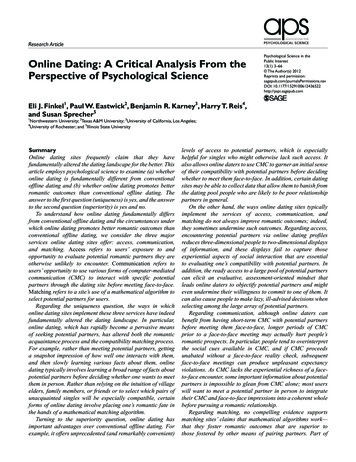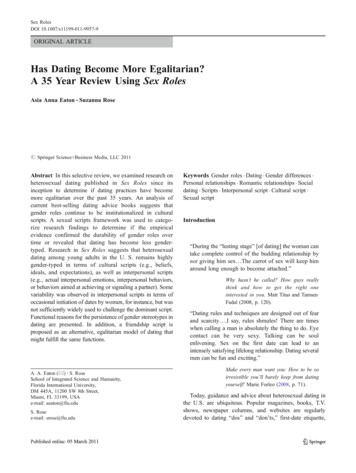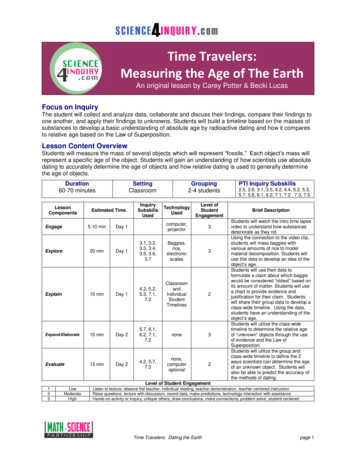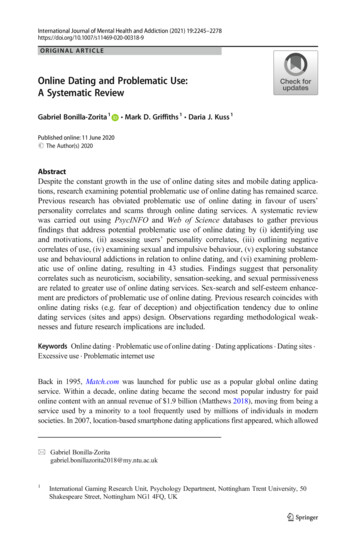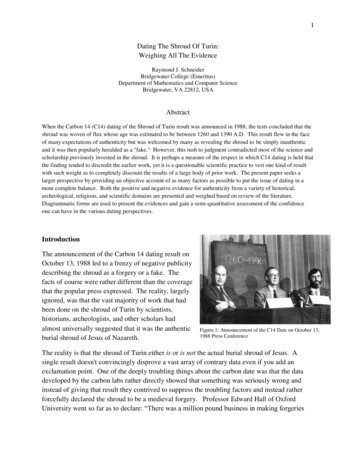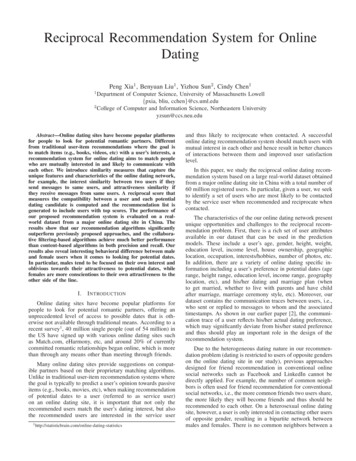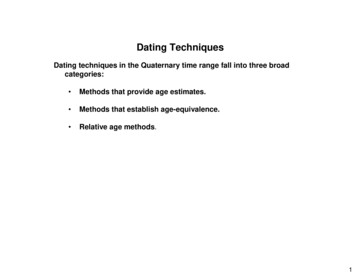
Transcription
Dating TechniquesDating techniques in the Quaternary time range fall into three broadcategories: Methods that provide age estimates. Methods that establish age-equivalence. Relative age methods.1
Dating TechniquesAge Estimates: Radiometric dating techniquesAre methods based in the radioactive properties of certain unstable chemicalelements, from which atomic particles are emitted in order to achieve a morestable atomic form.2
Dating TechniquesAge Estimates: Radiometric dating techniquesApplication of the principle of radioactivity to geological dating requires thatcertain fundamental conditions be met.If an event is associated with the incorporation of a radioactive nuclide, thenproviding:(a) that none of the daughter nuclides are present in the initial stages and,(b) that none of the daughter nuclides are added to or lost from the materials tobe dated,then the estimates of the age of that event can be obtained if the ration betweenparent and daughter nuclides can be established, and if the decay rate isknown.3
Dating TechniquesAge Estimates: Radiometric dating techniques - Uranium-series dating238Uranium, 235Uranium and 232Thorium all decay to stable lead isotopesthrough complex decay series of intermediate nuclides with widely differing halflives.4
Dating TechniquesAge Estimates: Radiometric dating techniques - Uranium-series dating Bone Speleothems Lacustrine deposits Peat Coral5
Dating TechniquesAge Estimates: Radiometric dating techniques - Thermoluminescence (TL)Electrons can be freed by heating and emit a characteristic emission of lightwhich is proportional to the number of electrons trapped within the crystal lattice.Termed thermoluminescence.6
Dating TechniquesAge Estimates: Radiometric dating techniques - Thermoluminescence (TL)Applications: archeological sample, especially pottery. deep sea sediments and, loess 7
Dating TechniquesCosmogenic DatingCosmogenic isotopes are created when elements in the atmosphere or earthare bombarded by high energy particles (cosmic rays) that penetrate into theatmosphere from outer space. It was discovered about a decade ago thatcosmic ray interaction with silica and oxygen in quartz produced measurableamounts of the isotopes Beryllium-10 and Aluminium-26.8
Dating TechniquesRadiocarbon DatingFree neutrons resulting from nuclearreactions in the upper atmospherecollide with other atoms andmolecules, and one effect is thedisplacement of protons fromnitrogen atoms to produce carbonatoms.9
Dating TechniquesRadiocarbon DatingAll living matter that absorbs carbondioxide during tissue-building,therefore, contains carbon isotopes in aratio which is in equilibrium withatmospheric carbon dioxide.Upon death, 14C within the inorganictissues will continue to decay, but noreplacement takes place, Hence if therate of decay of 14C is known, date ofdeath can be computed from themeasured 14C .gif10
Dating TechniquesRadiocarbon DatingRadiocarbon dating rest on four fundamental assumptions: that the production of 14C is constant over time that the 14C: 12C ratio in the biosphere and hydrosphere is inequilibrium with the atmospheric ratio, that the decay rate of 14C is known; and that an equilibrium constant has been achieved between production anddecay, which does not vary substantially over time.11
Dating TechniquesSources of error in 14C dating Variations of 14C over time. Circulation of marine carbon. Hard water. Contamination.12
Dating TechniquesIncremental MethodsIncremental methods are those based on regular additions of material to organictissue or sedimentary sequences. Those which have been most widely usedare1. dendrochronology (tree-ring dating),2. varve chronology, and3. lichenometry.These techniques are restricted in application largely to the Holocene althoughvarve chronology has been used as a means of dating earlier Quaternarysuccessions.13
Dating TechniquesDendrochronologyIn most temperate trees, new water and food-conducting vessels are added tothe outer perimeter of the trunk each growth season, following an interactiveperiod in winter. This produces a distinct line between successive annualincrements of wood growth and counting of these lines (tree-rings) allows theage of the tree to be established.14
Dating TechniquesDendrochronologyObtain a core or cut dead tree for cross-section.15
Dating TechniquesDendrochronology Ring patterns within trees from a limited geographical area can be matchedthrough the technique of cross-dating. Climatic variations within a particular area will be reflected in characteristicring-width patterns in the trees of that area. Distinctive rings, or grouped of rings, form markers and these can be usedas a basis for cross-matching between trees of overlapping age range.02 999 997 99402 1 1116
Dating TechniquesVarve ChronologyRhythmic accumulations of sediments (varves),forming laminae of fine sands, silts or clay, arecommon in the geological record.Because they are deposited annually, varves can beused as a means of dating, for time intervals canbe calculated and a floating chronologyestablished. it may be possible to assign calendardates to the varve record.17
Dating TechniquesGlaciolacustrine and glaciomarine varvesLarge supplies of sediment are deposited inproglacial lakes and shallow seas as a resultof rapid spring and summer ice melt.18
Dating TechniquesOther varved sediments In deep lakes with oxygen deficient basal water, the numbers of bottomdwelling fauna are restricted, vertical water circulation does not extend to thebottom of the water column and fine laminations may be preserved. Diatom-rich summer layers in lamination have been observed in interglacialand modern sediments. Seasonal variation in iron oxide precipitation may also lead to the formationof laminations. In some lakes, variations in the accumulation of organicmatter or of chemical precipitates are superimposed on particle-sizevariations, thereby emphasizing contrasts between winter and summerlayers.19
Dating TechniquesLichenometryLichenometry as a dating technique rests on the principle that there is a directrelationship between lichen size and age.Lichenometry has been most widelyemployed in the dating of lichen04.jpg20
Dating TechniquesLichenometryNot all lichens are suitable for lichenometrical purposes, however; only thosethat show a gradual and progressive rate of growth can be .jpg21
Dating TechniquesAge-equivalent stratigraphic markersIn many Quaternary deposits, distinctivemarker horizons are found that arebroadly synchronous and form timeplanes across different sedimentarysequences. Paleomagnetism Tephrachronology /lec10/f10b2.jpg22
Dating TechniquesPaleomagnetismThe earth’s magnetic field varies constantly both in field strength and in polaritydirection. Rocks and unconsolidated sediments containing magneticminerals are magnetized during formation, and individual crystals or particlestherefore become aligned in the ambient magnetic field.23
Dating TechniquesPaleomagnetismVolcanic rocks contain minerals with various ferromagnetic properties. Thepresence of a magnetic field then influences and aligns the orientation offerromagnetic minerals.Sedimentary rocks and unconsolidated sediments accumulating on the seafloor or in lakes also contain evidence of former geomagnetic fields, for arecord is preserved in the alignment of ferromagnetic sedimentary particlesas they settle in water or in water-saturated pg24
Dating TechniquesMagnetostratigraphyThe study of variations in magnetic properties through a sequence of rocks orsediments is termed magnetostratigraphy. provides a means of relativedating and correlation.Field reversals and the paleomagnetic time-scaleFrom time to time the geomagnetic field reverses so that the geomagnetic poleschange relative positions through 180 and these then remain stable for awhile. These polarity reversals can be detected in the geological record andare of fundamental importance in paleomagnetic studies.25
Dating TechniquesMagnetostratigraphy26
Dating TechniquesTephrachronologyFollowing a volcanic eruption ash or tephra is often spread rapidly over arelatively wide area and forms a thin cover over contemporaneous peatsurfaces, lake floor sediments, estuarine sediments, river terraces, etc.27
Dating TechniquesRelative chronology based on processes of chemical alterationFossils, sediments and rocks are affected by a number of chemical reactionsthat are partly time-dependent. The degree of alteration brought about bydifferent chemical reactions increases with time, and this therefore offers abasis for relative jpg28
Dating TechniquesRelative chronology based on processes of chemical alterationBiogeochemistry of amino acids (aminostratigraphy)All living organisms contain proteins made up of amino acids. The proteinsproduced by organisms consist almost entirely of amino acids in the Lisomer (left-handed) configuration. Upon death, the L amino acids begininverting to their respective D-isomer (dextral or right-handed)configurations. This process is called racemization.The use of amino acids ratios to rank fossils and their associated sedimentsaccording to relative age is termed aminostratigraphy.29
Dating Techniques Radiocarbon Dating Radiocarbon dating rest on four fundamental assumptions: that the production of 14C is constant over time that the 14C: 12C ratio in the biosphere and hydrosphere is in equilibrium with the atmo
